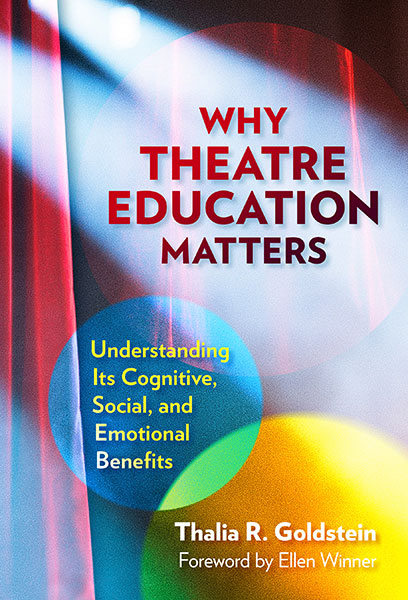By: Thalia R. Goldstein and Ellen Winner

 What follows is part two of a June 21, 2024 conversation between Thalia R. Goldstein, associate professor and director of the Applied Developmental Psychology Program at George Mason University, and Ellen Winner, professor emerita of psychology at Boston College and a senior research associate at Project Zero, Harvard Graduate School of Education.
What follows is part two of a June 21, 2024 conversation between Thalia R. Goldstein, associate professor and director of the Applied Developmental Psychology Program at George Mason University, and Ellen Winner, professor emerita of psychology at Boston College and a senior research associate at Project Zero, Harvard Graduate School of Education.
Winner is a coauthor of Studio Thinking 3: The Real Benefits of Visual Arts Education and Studio Thinking From the Start: The K–8 Art Educator’s Handbook. As part of the team that developed the Studio Thinking books, she helped introduce a framework that identifies eight habits of mind taught in visual arts.
Using the habits of mind framework as a point of departure, here the authors discuss Goldstein’s new book, Why Theatre Education Matters: Understanding its Cognitive, Social, and Emotional Benefits, and the benefits of arts education generally.
The conversation has been lightly edited and condensed for clarity.
In Part 1, the authors discuss the foundations of the Habits of Mind framework, the question of what the arts empirically teach, and the complexity of integrating the techniques in a classroom environment.
Part 2 of 2: Using the Acting Habits of Mind
Thalia Goldstein: Do you think artists and student artists have favorite ways of using habits of mind to approach different problems? Do you think some artists are more “envisioners,” some are more focused on the craft of it, and some are focused on critiquing? Do you think there are individual differences in the use of habits of mind?
Ellen Winner: Well, on the face of that, that sounds very reasonable, and so I would say, I’m sure that’s true. But I haven’t studied it, and so I would hesitate to say, well, Picasso was an envisioner, and Matisse was an observer. But I’m sure there are individual differences in the way artists work just as I’m sure you would think in the way actors work.
TG: I think there are, because of the analyses for Habits of Mind in this book: there are moments in acting classes where teachers promote a particular acting skill which is more dependent on one of the Acting Habits of Mind.
There’s this game we saw over and over again called Machine, where one student comes up to the middle of the stage and starts making a motion and a sound, and then a second student adds on to that motion and sound, then a third student adds, a fourth, etc., until you have the whole classroom in one big beeping, booping, whirring machine. And this is a game that comes from the mother of improv theatre, Viola Spolin. She wrote about it as a way to release inhibitions and be playful, without using so many words.
Machine requires students to engage in body control, to release inhibitions, and to collaborate. But the teachers vary when they talk about the use of this game. Some talked about it in terms of a “collaborative” exercise, and others in terms of a “use of space” exercise. Teachers have different perspectives on which exercises they’re using, and for which kinds of goals. I think students also bring to the table what they’re focused on at any particular moment in the classroom.
What I think is so wonderful about the Habits of Mind framework for all different art forms, is that they’re approaches to the work rather than singular, mechanistic, psychological perspectives. They are like a toolkit that can be used to work on problems.
That’s one of the major conclusions I come to in the book. Theatre is a flexible toolkit that can be used for lots of different student populations, for lots of different outcomes, and for lots of different goals teachers may have for their students.
“Theatre is a flexible toolkit that can be used for lots of different student populations, for lots of different outcomes, and for lots of different goals teachers may have for their students.”
EW: That leads to a question I have. What if somebody said to you, why do any of these Habits of Mind matter? Why is it important for kids to experience and develop these Habits of Mind?
TG: I think the Acting Habits of Mind give students practice at taking various approaches to solving problems and engaging in tasks in theatre classrooms. And I think theatre in particular is all about being a human, telling the stories of being human, working in societies, and telling the stories of working in societies. These are the skills children need in order to learn about themselves, learn about the people around them, and learn how to interact with the world.
Collaboration is inherent in theatre. Approaching a theatrical problem from a perspective of collaboration means you can’t just take the first thing that pops into your head and run with it. You have to think about how your actions are going to affect other people, and how other people’s actions are going to affect yours.
And I really think about the Habits of Mind as scaffolding—you can hang whatever kind of problem, or whatever kind of objective, or whatever kind of context you want, on them. The habit of collaboration: it’s a skill that, no matter what kind of job you’re in, you’re going to have to collaborate in some way. It’s the basis of relationships. It’s the basis of being in community, which we know is good for both health and well-being. I think there’s not this one-to-one, mechanistic, direct line dosage. But I think the idea of being flexible, of having lots of different skills, of thinking about problems in lots of different ways, is what we want forming the foundation for what kids do outside of their art forms.
“It felt like it was giving a language to what teachers were already doing.”
EW: There’s no reason to say there’s no such thing as transfer. It’s just, now that you know about the habits of mind being taught, they may well generalize to other areas. It’s not the justification for theatre education, but the idea of considering others, the idea of collaboration. Those habits of mind are really important in other areas as well. So there’s no reason to think they don’t transfer.
TG: How has Studio Thinking been received by arts teachers? Do arts teachers talk about transfer?
EW: We were kind of blown away it became so viral. We did not expect this. We were thrilled about it. But our teachers just latched onto it. It felt right to them, and it felt like it was giving a language to what they were already doing.
“An education without the arts is really sorely lacking.”
TG: The last question I wanted to get to is about policy and defunding. You started the habits of mind work from the question, What is true? What does the evidence show us? You wanted to see what was actually in the data. And then what you got was this really harsh pushback from policymakers, from advocates, worried about the funding. And then, of course, we know the truth is over the last 25 years arts education has been even more radically defunded than it was before. And policy has not helped protect it.
So how do you think about advocacy and policy and economics and funding?
EW: It’s very sad, I mean. But clearly our REAP study did not cause the defunding. Nor did our Studio Thinking study cause a rise in funding.
Yes, so the sad truth is, American education is in really bad shape. You have enclaves of excellent public schools and enclaves of excellent independent schools, where the arts are strong. And theatre has always been less strong in schools because visual arts and music are always required at some level, at some point in time. But I’ve never heard of a school that requires theatre, right? It’s always an extracurricular. So we need to get our heads around training teachers better, paying them better, teaching them and treating them as professionals. Those are general problems, and realizing that an education without the arts is really sorely lacking.
I don’t think kids necessarily have to have all the arts. I think that’s unrealistic, but I think it would be great if kids had the choice of, say, one of four art forms and they could focus on that. But that requires a school have the option for kids to have all four.
I think we should look at what happens in other countries. In Germany, for instance, they’re much stronger in visual arts education. I write about that in my book, An Uneasy Guest in the Schoolhouse. All we can do is keep on studying what really goes on in arts classrooms, and broadcasting those findings, so people will have a language of justification.
TG: When COVID hit everybody ran to the arts. The first thing we all did was put on music and watch movies and find TV shows to talk about. And you know all of the major arts organizations put their work online and saw major levels of donations. In times of stress and in times of disconnection people flock towards the arts, people are desperate for them, and I think we forget over and over again that this is what people want to spend their time on.
When people retire, they want to be artists. When you give children free time, they want to play, and they want to make art. I think we so often forget it is so foundational and fundamental to what we all want—for a feeling of well-being and a feeling of connection. And I think schools without that are really, really absent.
EW: Exactly. It’s important for students to learn different habits of mind, habits of mind of math, habits of mind of art, science. . . we should be exposing students to all of the most important disciplines humans have created, and to learn how to practice thinking in that way.
Historians don’t think like mathematicians, and kids need to have authentic history in school where they’re actually practicing history by working like historians, by working with documents, coming up with interpretations and arguments, just like they need to have experiences where they learn to authentically think like artists.
TG: Yes.
EW: I congratulate you on this book. I think it’s wonderful you took this on, and I’m really thrilled to hear you say it grew out of the Studio Thinking Habits of Minds.
TG: Thank you. And thank you for chatting with me for so long. I really appreciate it.
EW: It was a pleasure.
 | Why Theatre Education MattersUnderstanding Its Cognitive, Social, and Emotional BenefitsThalia R. Goldstein |
Featured photo by Rob Laughter on Unsplash

